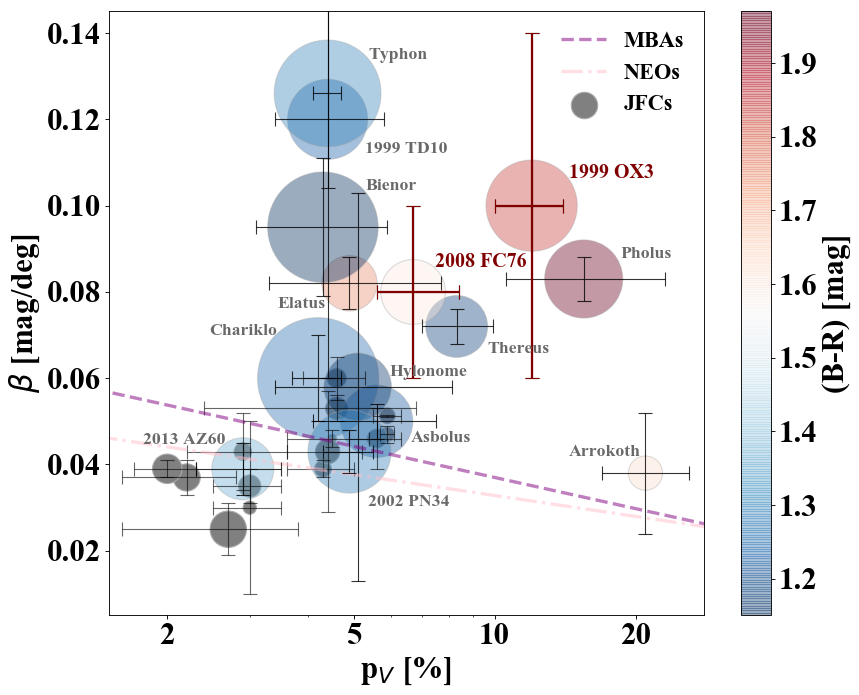Phase Functions and Rotational Light Curves of Centaur (281371) 2008 FC76 and Scattered Disk Object (44594) 1999 OX3
- 1European Southern Observatory, Garching bei München, Germany (rosita.kokotanekova@eso.org)
- 2Institute for Astronomy, University of Edinburgh, Royal Observatory, Edinburgh, UK
- 3Instituto de Astrofísica e Ciências do Espaço, Universidade de Coimbra, Portugal
Centaurs and Scattered disk objects (SDOs) are believed to be the main source populations of Jupiter-Family comets (JFCs). Despite being essential for understanding cometary evolution, due to their large heliocentric distances these two populations are among the least studied in the Solar System. One interesting aspect that remains relatively under-examined is the comparison between the surface properties of Centaurs, SDOs and JFCs. While the colors/spectral slopes of these populations have been the subject of numerous works (see [1,2]), their phase functions remain largely unexplored, last reviewed over a decade ago [3]. In this work we focus on characterizing the shapes of Centaur and SDO phase functions (linear slope and the presence of an opposition surge), as well as on comparing their phase-coefficient—albedo relationship to that of JFCs.
We obtained relatively sparse photometry of two objects - Centaur (281371) 2008 FC76 and SDO (44594) 1999 OX3, in order to improve their phase functions, albedos and rotational light curves. We followed the two targets using VLT/FORS2, NTT/EFOSC and LT/IO:O between December 2019 and January 2021. The photometric data were calibrated using Pan-STARRS field stars and combined to derive the rotational light curves, phase functions and albedos following the methods described in [4,5]. The new rotation periods and light curve amplitudes agree with the results previously published for 2008 FC76 [6] and 1999 OX3 [7]. However, the phase functions we determined are less steep than the estimates for 2008 FC76 (β = 0.09 ± 0.02 mag/deg [8]) and for 1999 OX3 (β= 0.30 $± 0.03 [7]). Using the new linear phase coefficients we also derived the absolute magnitude of the two targets and updated their geometric albedos using their diameters [9].
We added these two objects to the sample of twelve other inactive Centaurs and SDOs with well-constrained albedos and phase functions. In earlier work, we identified a correlation of increasing albedo for increasing phase coefficients using ground-based and spacecraft observations of 14 JFCs [4,5]. This was interpreted as an evolutionary path of JFCs according to which dynamically young JFCs start their evolution with relatively large albedos and steeper phase functions. Then, during their lifetimes, sublimation-driven erosion gradually makes the comets' surfaces smoother, and their phase-function slopes and albedos decrease.
The database of 14 Centaurs and TNOs allows us to test whether the outer solar system progenitors of JFCs support this interpretation and have predominantly larger albedos and steeper phase functions. As it can be seen in Fig. 1., the majority of the Centaurs and SDOs follow the phase-function—albedo correlation of JFCs. However, some of the objects with geometric albedo ~5% have larger phase coefficients than comets with similar albedos. This can be attributed to the observation that all of the phase coefficients from this group were derived for narrow ranges of small phase angles (0.5-3.5° (Fig. 2.), which suggests that these observations probe the phase functions’ opposition surge. Additionally, in order to test the hypothesis that the evident phase-function albedo correlation represents the surface evolution of objects subjected to increasing solar insolation, we complement our analysis with numerical simulations to constrain the dynamical history of these objects.
In addition to the insights on the surface properties of Centaurs and SDOs and their relationship to JFCs, this work provides findings that can serve as a foundation for future phase-function studies (e.g. the Vera Rubin Observatory’s Legacy Survey of Space and Time; LSST). Improving our understanding of the phase function shapes of different populations is essential for eliminating the possible biases in extracting the objects’ absolute magnitudes from sparse photometric datasets.

Fig.1. Linear phase function coefficient against geometric albedo in V-band for JFCs (in gray) and Centaurs/SDOs (in color). The size of the symbols corresponds to the relative size of the objects. The color of the Centaurs and SDOs correspond to their (B-R) color index. The purple dashed line shows the phase-coefficient—albedo correlation for Main Belt asteroids [10] and the pink dash-dotted line represents the correlation found for Near-Earth asteroids [11]. The Cold Classical Arrokoth whose linear phase coefficient was derived in the range 1.3° - 32.5° during the New Horizons flyby [12] is added for comparison.
Fig. 2. Phase angle range used for the derivation of the phase coefficients of the Centaurs and SDOs.
References:
[1] Peixinho, N. et al. (2020), The Trans-Neptunian Solar System, 307
[2] Jewitt, D. (2015), AJ, 150(6), 201
[3] Belskaya, I. et al. (2008), The Solar System Beyond Neptune, 115
[4] Kokotanekova, R. et al. (2017), MNRAS, 471, 2974
[5] Kokotanekova, R. et al. (2018), MNRAS 479, 4665
[6] Hromakina, T. et al. (2017), MNRAS, 474, 2, 2536.
[7] Thirouin, A. et al. (2014), A&A, 569, A3.
[8] Perna, D., et al. (2013), A&A, 554, A49.
[9] Müller, T. et al. (2020), The Trans-Neptunian Solar System, 153
[10] Belskaya, I. N., & Shevchenko, V. G. (2000), Icarus, 147, 94
[11] Hergenrother, C. et al. (2013), Icarus, 226, 1, 663
[12] Stern, A. et al. (2019), Science, 364(6441).
How to cite: Kokotanekova, R., Snodgrass, C., Donaldson, A., Lacerda, P., and Opitom, C.: Phase Functions and Rotational Light Curves of Centaur (281371) 2008 FC76 and Scattered Disk Object (44594) 1999 OX3, European Planetary Science Congress 2021, online, 13–24 Sep 2021, EPSC2021-668, https://doi.org/10.5194/epsc2021-668, 2021.

